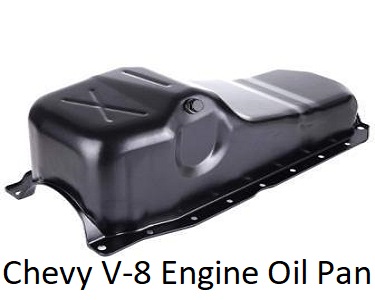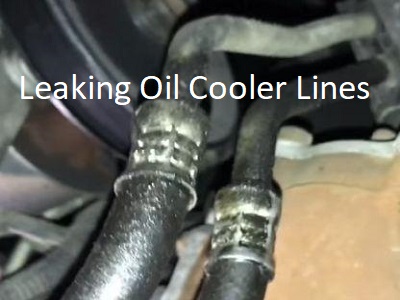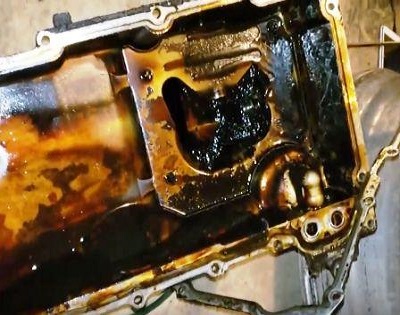Chevy V8 Oil Pan Leak
I've seen Chevy V8 oil pan leak issues on trucks less than 10 years old and under 100,000 miles. With that said, all of the trucks I repaired myself showed over 150,000 miles on the odometer. Let me tell you why.
The seepage around the oil pan gasket starts off slowly and also progresses slowly. Therefore, when the truck begins to leak oil, it seems an issue the driver can live with.
However, as time marches on and the spots get larger in the driveway, people often decide to go ahead and replace the oil pan gasket.
In this article we'll talk about how to replace the composite gasket, diagnose additional leak prone areas and picking the right parts.
New Parts: Chevrolet oil pan gasket sets for popular models.
Quick link: Chevy Oil Cooler Fittings and Engine Oil Cooler Lines Replacement Parts.
The nice thing about this job is the gasket runs about $40 and the rest of the work is all labor. If you think this repair falls in your wheelhouse, you'll enjoy doing the repairs on the cheap.
Before we get into the diagnostic section I wanted to mention that I spent most of my career as a certified Chevrolet technician.
I also worked for Pontiac, Ford and Mazda towards the end of my dealership career. You can learn more about my history here.
 Old Style Chevrolet Oil Pan
Old Style Chevrolet Oil PanWith that said, in the early 90s I went to the GM training center as they unveiled these new composite style oil pan and valve cover gaskets.
A composite gasket is simply made of more than one type of material. In the case of the Chevy V8 oil pan leak, we have a metal and silicone rubber gasket combination riveted directly to the pan.
We drooled over the much improved gasket as compared to the cork or fiber style used for the prior 100 years. Then the instructor informed us that this part carried the lifetime gasket designation.
This meant when you removed the oil pan for service, General Motors expected technicians to reuse the oil pan gasket for the rest of the vehicle's life.
Maybe Chevrolet didn't think the truck would last for 20 years and a couple hundred thousand miles?
Anyway, if you keep your Chevy truck long enough, you'll probably have to replace the oil pan gasket. Now let's talk about getting the diagnosis right.
Chevy V8 Oil Pan Leak Diagnosis
 Common Oil Cooler Line Leak
Common Oil Cooler Line LeakOf course, the easy way to tell that you have just an oil pan leak is when the engine is completely dry above the oil pan gasket line.
If wetness exists only below the sealing surface you're most likely looking at the standard variety of Chevy V8 oil pan leak.
Unfortunately, as these trucks age they can often develop additional problems in other areas. A good example of this remains the plastic intake manifold set up on the V8 models.
Often the front or back seals begin to seep oil. Then it drips down the block and blows all over the place as the truck rides down the road in a 60 mile per hour wind.
Here's my first piece of advice. If there is any doubt in where the wetness came from, take the time to clean and dry the area.Then a good road test with lots of turns before rechecking the leak.
In addition, there's another common leak prone area near the oil pan gasket. The engine oil cooler lines use a combination rubber and metal line. This allows the engine to jump around and the radiator to stay still.
At the union of these two different materials the factory applied a crimp fitting known to seep oil as the truck ages.
Since we have to remove these engine oil cooler lines anyway, now is a good time to take care of this issue if it applies to your situation.
Back on the older Chevrolet V-8 pickup trucks, a wet engine oil pan often meant a leaking rear main seal.
General Motors as a company put a lot of research and development into improving the rear main seal. First they went from a two piece set up to a one piece.
Then they improved the new design rear main several times over the last two decades. Long story short, depending on the miles showing on the odometer and the engine size, you might also find a seeping rear main seal.
With that said, on Chevy trucks from 1998 through 2007 with the 4.8 L, 6.0 L and the 285 hp 5.3 L V8 we often find the rear main seal doesn't require service.
Removing the Chevrolet V8 Oil Pan
 Chevy V8 Oil Pan Removed
Chevy V8 Oil Pan RemovedA couple of points to highlight before we talk about the replacement of the Chevy V8 oil pan gasket. If you look under the vehicle, the oil pan appears impossible to remove.
However, unlike previous years the 1998 through 2007 V8 trucks have a removable cross member.
In the old days we had to take the engine mounts loose and jack the engine up to gain enough clearance to fish the oil pan out. Not anymore. Remove the cross member and then remove all of the oil pan bolts and it drops right out.
Another important point to make is when you remove the oil pan, the factory installed gasket is actually riveted on. This means you'll need to carefully drill out the rivets to install the new gasket. You don't have to rivet the new gasket on, but reassembly becomes a lot easier if you do.
Cleaning the gasket surfaces on the oil pan and the engine side sealing surfaces remains extremely important.
If the oil pan has been leaking for a while, you'll find hard to remove deposits. Remember that you are dealing with an aluminum surface.
Bake cleaner, rags and a razor blade scraper remain the best tools to remove deposits and maintain the integrity of the surface. This becomes a rare opportunity to clean the sludge from the sump and oil pick-up screen areas.
When you put everything back together it's important to remember not to over tighten the oil pan bolts. The factory torque specification for the pan bolts comes in at 18 inch pounds and 12 inch pounds for the two longer bolts.
Over tightening can actually damage the gasket and cause a leak. Here's an excellent video outlining oil pan replacement procedures.
The last thing to talk about is giving yourself enough room under the truck to work. I try not to lift the truck at all if I'm doing the work in my driveway.
However, I would prefer to use ramps and jack stands as opposed to a floor jack for safety reasons. In the end, it is sometimes the space between the ground and the oil pan that causes DIY mechanics to struggle with the oil leak repair job.
This Chevy V8 oil pan leak article fits in well with our GM truck and miscellaneous car repair series. If you own a Chevrolet Silverado or a GMC Sierra take a look at this article about defective ignition switches.
And if you're having issues with oil pressure readings take a look at this article outlining the Chevrolet oil pressure problem. For more information about this website return to the homepage.
Author bio : Mark is a retired ASE certified master technician, Chevrolet Professional Service Council member and the founder of FixMyOldRide.com. Watch the video on the about Mark the mechanic page to see his credentials. Mark hand writes all of the articles on FixMyOldRide.com unless indicated otherwise.